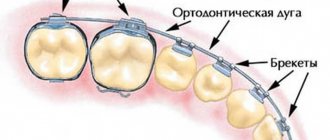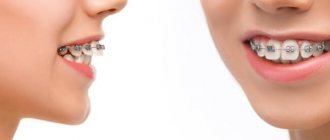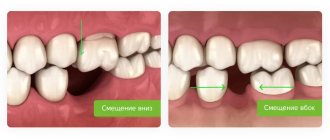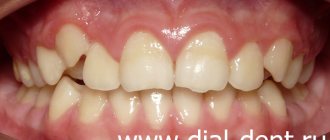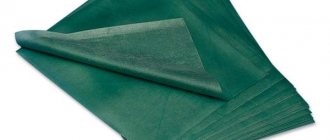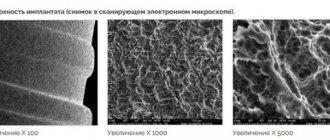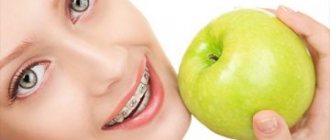Home / Braces
Back
Published: 06/23/2020
Reading time: 6 min
0
32
- 1 What do you need to know about arches for braces?
- 2 Braces scratch your cheek: what to do?
- 3 What to do if the archwire comes out of the bracket?
- 4 What to do to prevent braces from breaking?
- 5 The archwire flew out of the bracket, what should I do?
- 6 What to do?
- 7 If your teeth hurt
- 8 If the diction has changed
- 9 If the design scratches your cheeks or tongue
- 10 If a bracket falls off
- 11 How to insert an archwire into the last bracket
- 12 The tip of the arc has become very long
- 13 Treatment of damage to the oral mucosa.
- 14 Menu during orthodontic treatment
- 15 Expert opinion
- 16 The bracket fell off
- 17 Useful video
- 18 Problems and inconveniences during dental treatment
- 19 Problems with intermaxillary elastics
Braces scratch your cheek: what to do?
For sensitive and suspicious people, the answer to this question will be simple: “Consult a doctor!” But in fact, if braces scratch your cheek, then the intervention of an orthodontist is not always required; the discomfort can be eliminated on your own. Of course, this is only possible in the simplest cases. Let's take a closer look at them
You will have to look at it in the truest sense of the word - armed with a mirror and in good lighting. Calmly and carefully examine your mouth and braces: which part is causing you discomfort? Most often the problems are:
Damon product lines
Depending on their design and materials of manufacture, Ormco products are divided into the following categories:
- Damon Clear.
They contain polycrystalline aluminum - a unique substance, thanks to which stains do not appear on the tooth surface and the enamel does not darken. Patients with such braces can eat colored foods and drink coffee and tea without restrictions. This is an extremely important point, because after wearing ligature models, many clients are left with clearly visible marks on their front incisors. These enamel damages are noticeable when talking, smiling and eating, and to eliminate these defects, whitening will be required, which will put even more unwanted stress on the enamel. Patients with Damon systems will be free from such problems.
- Damon Clear 2.
This model is also made on the basis of polycrystalline aluminum and does not impose restrictions on the patient’s diet. However, there is another significant advantage: braces in this category are transparent, which means they are almost invisible in the mouth. With the help of 3D technologies, the orthodontist will be able to produce a system that will take into account the specific structure of the client’s oral cavity down to the smallest nuances.
- Damon 3.
These are ceramic non-ligature models that are characterized by minimal weight and dimensions. Their presence in the mouth is almost not felt, and they do not at all interfere with blood circulation. If you are afraid that braces will scratch your cheeks from the inside, then with Damon 3 such a problem will definitely not affect you.
- Damon 3 mx.
This model is characterized by increased strength and rounded shapes of all components. It is recommended for patients with sensitive mucous membranes, because it is guaranteed not to injure them. You will be able to move your tongue over any elements completely calmly.
- ● Damon Q.
These braces are extremely miniature and do not cause any inconvenience to the client. Their advanced Spin Tek latches feature sliding doors, making system adjustments even easier. Damon Q braces also have additional horizontal and vertical grooves.
During your initial examination, your orthodontist will explain which braces are best for you and how long you will need to wear them. Please note that of all the methods of bite correction available today, Damon is recognized as the most physiological - it is unlikely that you will be able to find a more aesthetic and less traumatic option.
ATTENTION:
Damon sapphire braces are called that not because they are made of precious stone. The system is made from ceramic, but since it is transparent and invisible in the mouth, it is figuratively compared to sapphire.
What to do if the archwire comes out of the bracket?
The arch can protrude and injure the soft tissues in the oral cavity. This can be very painful and only a doctor can help. He will either trim the ends of the arc or replace the structure.
If the wire falls out of the lock, which is not the last one, then you will also need to see a doctor, and as soon as possible. This is necessary because in this case the arch has changed its position and, instead of benefit, can cause harm; the incorrect position of the entire structure will distort the results already achieved and lead to a prolongation of treatment.
What to do if your braces come off?
Contact your orthodontist immediately and let him know. The bracket should be fixed for 1-3 days . Since the tooth, not attached to the arch, begins to return to its original position, which leads to the need to switch to previous arches: months of treatment are wasted. Moreover, this process is most critical in the middle and at the end of treatment, since during these periods thick and hard arches are used and even a slight displacement of the tooth can make it impossible to install the arch into the bracket groove. It should be noted that only those teeth that actively moved during orthodontic treatment have such a tendency, so it is important to inform the orthodontist from which tooth the bracket came off.
When removing the bracket, be careful not to swallow it! This does not pose a serious threat to health, but there is a small chance of injury to the mucous membranes of the gastrointestinal tract. The main problem is different: you will have to pay the cost of a new brace and, possibly, wait for the clinic to purchase it (the clinic does not always have a stock of all braces in its warehouse), which can increase the duration of your treatment. Most often, if the bracket comes off, it remains securely fixed on the arch, but at the same time is movable (see photo above). In this case, you do not need to do anything before visiting the orthodontist. But, if the braces come off from the last teeth, then they almost immediately fly off the arch and, in this case, it is important to notice the unsticking in time (often it happens while eating) and remove the bracket from the mouth, pack it and take it with you to the appointment to the orthodontist.
The archwire flew out of the bracket, what should I do?
- Most often, thin wires used at the beginning of treatment fly out of the last braces. Experienced orthodontists know how to minimize such phenomena. In particular, the arch can be bent behind the last bracket; in addition, thin arches are often placed only up to the sixth teeth, since they often fly out of the tubes on the seventh teeth. If this trouble nevertheless happens to you, try in front of a mirror using tweezers or nail clippers (just don’t bite off the arch!) to tuck the arch into the tube on the last tooth: this manipulation is akin to threading a thread through the eye of a needle. If you can’t do it or you don’t want to acquire new skills, then contact your orthodontist, he will quickly fix the problem.
- The arch can also shift due to low friction in the system (primarily applies to self-ligating braces). In this case, the archwire protrudes from one side and slides out of the last bracket on the other side. This happens because the orthodontist either forgot to fix the stoppers on the arch, or they turned out to be ineffective for one reason or another. The problem is resolved in the same way as the first point.
- When closing gaps or correcting crowding of teeth, the length of the dentition decreases, but the length of the arch remains the same; accordingly, excess arch length appears behind the last braces. If the tip of the arch is large enough and pricks your cheek, then visit your orthodontist (by prior arrangement, of course), he will remove the excess arch in a couple of minutes. If the tips of the arch are visible, but do not seriously bother you, then do not worry and come to the next scheduled appointment, because this is a sign of progress in correcting the bite.
We invite you to read: A white lump appeared on the gum of an adult: photo, how to treat
Removing the bracket
The locks of the system are attached to the enamel of the outer surface of the teeth using a special glue. The design is not intended for lifelong wear, therefore the characteristics of the glue are selected in a certain way: so that the lock holds securely, and at the same time it can be peeled off when the time comes. There are not many situations in which the bracket can come off spontaneously. This:
- excessive mechanical impact on the system when eating nuts, dried fruits, smoked meat, and products with a viscous consistency;
- physical impact: blow to the jaw, falling face down, careless use of a spoon, fork, toothbrush, etc.;
- crowding of teeth, due to which the pressure of the system is distributed quite unevenly on the braces;
- use of devices and devices for hygienic oral care that are not intended for cleaning braces;
- use of an inappropriate power arc;
- the teeth begin to touch the details of the structure as the bite normalizes;
- Poor-quality glue was used or the technology for gluing braces was violated.
If the lock comes unstuck, the simplest thing you can do is contact your doctor the same day. You should not postpone the visit, since the condition of the system directly determines the condition of the teeth. In the place where the lock has come unstuck, the system pressure decreases, and in others it increases. This changes the process of tooth displacement and negatively affects the condition of periodontal tissues.
If you can’t get to the clinic every day, you need to do the following:
- inspect the system and determine the breakdown;
- call your doctor and get instructions on your next steps;
- if everything happens at night or on weekends, when the doctor is unavailable, remove the bracket from the arch or fix the lock with dental wax so that it does not damage the mucous membranes.
A loose bracket hangs on the power arch. If possible, it should be removed. If it is secured with an elastic band, then disconnect the ligature. In self-ligating systems, it will be necessary to open the bracket clip that holds the power arch and remove the element.
You can do all this yourself if the broken bracket is located in front. On chewing teeth, all manipulations in front of a mirror are difficult. If you can’t remove the lock, you can glue it to a small ball of wax.
When heading to the clinic, you need to be prepared for the fact that the loose lock will have to be replaced with a new one, even if the old one looks perfect and has no external defects. If you insist strongly, the doctor will install the old element in place. However, in this case, we cannot exclude the possibility that the lock will come off again.
What to do?
If you have external braces:
— try to quickly make an appointment for an unscheduled appointment; - if you wear intermaxillary elastics, then stop wearing the elastics until the bracket is glued.
If you have internal braces:
— try to quickly make an appointment for an unscheduled appointment; - if you wear intermaxillary elastics, then stop wearing the elastics until the bracket is glued; - do everything so that the bracket does not get lost; - if this is a bracket on the last tooth, and the arch is not bent behind the bracket, then try to very carefully remove it from the arch and save it. If the bracket does not come off, do not apply any force; you may damage the adjacent bracket. Leave it in place, it won't get lost.
How are Damon braces installed?
All types of Damon System braces are installed according to the standard scheme, but the Spin Tek flap retainer allows this to be done much faster than when working with traditional ligature systems - the orthodontist only needs 40 minutes to completely fix the structure.
Before attaching the locks, the dentist etches the tooth enamel, cleaning and drying it, and then uses a special glue to fix the braces on the surface of the teeth. Then he “illuminates” the braces with an ultraviolet lamp so that the adhesive substance hardens, and if necessary, removes its excess. After installing the locks, the orthodontist connects them with an arch, which he inserts into the grooves.
If your teeth hurt
a) After installing braces, in the first 3-4 days you will experience pain only when biting or chewing food. It happens that teeth hurt for up to 10 days (very rarely). Sometimes there may be no pain at all, this is also normal.
b) After activation (control visit), during which the arch was replaced, the tooth/teeth may ache for 1-2 days, but also only while eating. Rarely do any patients resort to using painkillers these days, but if you feel the need for this, take those painkillers (ketanov, Nurofen, Nise, etc.) that you have on hand.
c) During the procedure for removing braces, the patient experiences slight discomfort (but it lasts 1-2 minutes) AND THAT’S ALL. THERE WILL BE NO OTHER PAIN SENSATIONS.
If the diction has changed
Diction may change slightly only with lingual (internal) braces. With the new miniature lingual braces INCOGNITO, there is virtually no impairment of diction. But if you still encounter a similar problem, short-term exercises with ditties and tongue twisters will help restore your eloquence:
There is firewood in the yard, the gang is on the firewood, the gang has grass, all the gang are used for firewood. Karl stole dollars from Clara, and Clara stole the quarterly report from Karl. The workers privatized the enterprise, privatized it, but did not privatize it. The beggar rustles in thousands and fifty thousandths. The highest echelons marched towards their sponsored people along the highway, drunk.
Regulators regularly adjusted the regulators. It is not clear whether the shares are liquid or not. Taxable grace. The guru's inauguration went off with a bang. The exhibitionist has small biceps. The moron got into the habit of doing bodybuilding. Sasha herself is perfection, and she’s also improving herself!
Unpromising. In Kabardino-Balkaria, valocardine is from Bulgaria. De-ideologized, de-ideologized, and pre-ideologized. He who does not work does not eat what he who works eats. Turner Rappoport sawed through the pass, rasp and support. Coconut cookers boil coconut juice in coconut cookers.
The eyes of a gazelle were staring at her from behind the spruce tree. Underqualified. Sasha walked along the highway and sucked on a dryer. Senya is carrying hay in the canopy, Senya will sleep in the hay. The cap is not sewn in the Kolpakov style, the bell is not poured in the Kolokolov style, the cap needs to be re-packed, re-capped, re-forged, re-capped. The heron wasted away, the heron was withered, the heron was dead. From under the Podvypodvert
After 3-4 days of training, your diction will become even better than before installing braces.
Problems and inconveniences during dental treatment
After installing the braces system and starting treatment, the patient may experience various inconveniences. We have prepared special material on the most common problems and ways to solve them.
If something scratches
Take a mirror and look at your teeth in bright light. Try to find out which part of the system scratches the mucous membrane of the tongue or cheek. During the first 2-3 weeks, the uneven edges of the braces may scratch or rub the mucous membranes of the cheek, lips or tongue. If this causes serious inconvenience to you, take the protective wax that we gave you on the day your braces were installed. But remember that without wax you will quickly get used to orthodontic equipment.
Video about using orthodontic wax
Take a small piece out of the wax box, roll a small ball in your hands and knead it on the protruding hook of the bracket. The bracket itself or the tip of the arch, first blot saliva with a paper napkin. After some time, the wax may fall off, then repeat this procedure again.
Metal ligatures (white metal ligatures). The tails remaining from metal ligatures are bent towards the tooth and usually do not interfere at all. If, within a month of actively brushing your teeth with a brush, the tail of the ligature becomes bent and scratches the oral mucosa, then the patient, independently, but very carefully, can bend the tail of the ligature under the arch with half a wooden toothpick.
Arc problems
The arch is not fixed rigidly in the locks on the last teeth. It fits freely into the locks and can move back and forth without restrictions.
1. If, while eating, the initial super-elastic arch has popped out of the last lock and is in the way, you can insert it back yourself. To do this you need a mirror, good lighting and tweezers (nail clippers). With one hand, pull back the cheek, and with the other, take the tip of the arch with tweezers, very carefully, without bending the arch 90 degrees, insert it into the lock (the lock is a tube into which the arch is inserted).
Read also: Malocclusion how to treat
2. The tip of the arc digs into the gum or cheek. As the teeth are aligned, the arch takes on a more even shape, and the end of the arch may come out of the last locks, injuring the mucous membrane of the cheeks or gums. In this case, if this causes serious discomfort (“I can neither eat nor speak”), you can come up without an appointment and the doctor or his assistants will cut off the problematic tip of the arch (if the tip has protruded by more than 3 mm).
If your teeth hurt
a) After installing braces, in the first 3-4 days you will experience pain only when biting or chewing food. It happens that teeth hurt for up to 10 days (very rarely). Sometimes there may be no pain at all, this is also normal.
b) After activation (control visit), during which the arch was replaced, the tooth/teeth may ache for 1-2 days, but also only while eating. Rarely do any patients resort to using painkillers these days, but if you feel the need for this, take those painkillers (ketanov, Nurofen, Nise, etc.) that you have on hand.
c) During the procedure for removing braces, the patient experiences slight discomfort (but it lasts 1-2 minutes) AND THAT’S ALL. THERE WILL BE NO OTHER PAIN SENSATIONS.
Food restrictions
To avoid damage to the equipment, you may need to avoid certain products. It is impossible to list all the foods that cannot be eaten, but each patient must determine for himself the force with which he can bite into his favorite food without damaging the braces.
We recommend not to eat: nuts (in any form), crackers, dried fruits, hard confectionery, caramel, toffees, sweets (especially grilled), hard toast, unhulled seeds, popcorn, chips. Raw carrots, radishes, turnips, hard fruits (apples, pears can be cut into slices), fruits containing seeds (peaches, plums, apricots, cherries, it is better to break them, cut them or separate the stone).
In the first months of treatment (in the initial arcs), you should not combine cold and hot foods together (ice cream and coffee, cold yogurt and a hot drink, etc.). Sudden temperature changes can disrupt the properties of the arc (the most important element in the bracket system).
If a brace falls off
Why do braces fall off, reasons?
1. When chewing or biting off hard food. 2. If you try to pick out something stuck under the archwire or between the braces on your own. 3. If the teeth have changed their position and there is contact of any tooth with the brace of the opposite jaw. If you do not notice this and do not tell the doctor about it, then, most likely, the braces will fall off as soon as you eat or when you force your teeth together.
Often in such cases, the patient does not immediately detect this problem. And to his surprise, while brushing his teeth or the next day, he identifies a lock that has fallen off, for a reason unknown to him.
What to do?
If you have external braces:
— try to quickly make an appointment for an unscheduled appointment; - if you wear intermaxillary elastics, then stop wearing the elastics until the bracket is glued.
If you have internal braces:
— try to quickly make an appointment for an unscheduled appointment; - if you wear intermaxillary elastics, then stop wearing the elastics until the bracket is glued; - do everything so that the bracket does not get lost; - if this is a bracket on the last tooth, and the arch is not bent behind the bracket, then try to very carefully remove it from the arch and save it. If the bracket does not come off, do not apply any force; you may damage the adjacent bracket. Leave it in place, it won't get lost.
If the diction has changed
Diction may change slightly only with lingual (internal) braces. With the new miniature lingual braces INCOGNITO, there is virtually no impairment of diction. But if you still encounter a similar problem, short-term exercises with ditties and tongue twisters will help restore your eloquence:
There is firewood in the yard, the gang is on the firewood, the gang has grass, all the gang are used for firewood. Karl stole dollars from Clara, and Clara stole the quarterly report from Karl. The workers privatized the enterprise, privatized it, but did not privatize it. The beggar rustles in thousands and fifty thousandths. The highest echelons marched towards their sponsored people along the highway, drunk. Regulators regularly adjusted the regulators. It is not clear whether the shares are liquid or not. Taxable grace. The guru's inauguration went off with a bang. The exhibitionist has small biceps. The moron got into the habit of doing bodybuilding. Sasha herself is perfection, and she’s also improving herself! Unpromising. In Kabardino-Balkaria, valocardine is from Bulgaria. De-ideologized, de-ideologized, and pre-ideologized. He who does not work does not eat what he who works eats. Turner Rappoport sawed through the pass, rasp and support. Coconut cookers boil coconut juice in coconut cookers. The eyes of a gazelle were staring at her from behind the spruce tree. Underqualified. Sasha walked along the highway and sucked on a dryer. Senya is carrying hay in the canopy, Senya will sleep in the hay. The cap is not sewn in the Kolpakov style, the bell is not poured in the Kolokolov style, the cap needs to be re-packed, re-capped, re-forged, re-capped. The heron wasted away, the heron was withered, the heron was dead. From under the Podvypodvert
After 3-4 days of training, your diction will become even better than before installing braces.
Problems with intermaxillary elastics
1.
Take your time to remove the elastic on the first day of your appointment. Before removing the rubber bands the doctor put on, study which tooth they were put on, so as not to confuse them in the future, because... it makes a big difference. And neither the administrator nor the doctor will help you over the phone.
2.
It happens that elastics break within a day. Because one elastic should be changed 1 or 2 times a day (as prescribed by the doctor), we recommend carrying a bag or small box with a small number of replacement elastic bands.
3.
You need to remember and know what animal is drawn on your bag, because... Sometimes the rubber bands in the bags run out, and the patient or his parents can drive up to the clinic, name the animal on their bag to the administrator and receive a new bag of rubber bands. Or tell your doctor about it at your scheduled visit.
It is important not to take breaks in wearing, because... The result achieved in months, you can lose in a week of not wearing elastics. Only a doctor can cancel elastics. Just because your bag is out of rubber bands doesn't mean you don't need to wear them anymore.
4.
If the hook falls off, the arch jumps out of the lock, the lock on which the elastic was put on, or any other lock breaks while wearing elastics, then in this case you need to stop wearing elastics and report the problem to the clinic.
During treatment there will be some mobility , this is normal. Don't panic, your tooth won't fall out and won't go anywhere. Many people don't notice this at all.
The tooth is fixed in the bone tissue by connective tissue ligaments. When straightening teeth, at the beginning of treatment, these ligaments are stretched, and the tooth acquires slight mobility, but when the tooth is installed in its final position, in the second half of treatment, these ligaments are shortened, the tooth is strengthened in the bone tissue and its mobility decreases. Temporary gaps (cracks) may appear between the teeth in the first half of treatment, but by the end of treatment all gaps will be closed.
And of course, our specialists are always ready to help you by phone:
If the design scratches your cheeks or tongue
The first thing you should do is pick up a mirror and look at your teeth in bright light - you need to try to understand which part scratches the mucous membranes of the mouth. During the first couple of weeks, the not quite straight edges of the braces often scratch or rub your lips, tongue and cheeks - this is considered normal. If such rubbing bothers you greatly, then use a special protective wax. Remember that waxing will take longer to get used to your braces.
Special protective wax
Sometimes the tail from the metal ligature begins to scratch the cheek. In general, ligatures are bent towards the teeth and should not interfere, but due to active brushing of teeth, their tails sometimes bend. In this case, you don’t always need to run to the dentist - you can carefully bend the tail of the ligature under the arch yourself, using a toothpick for this.
We invite you to familiarize yourself with the Irrigator for washing the tonsils: the effectiveness of the procedure - Denta master
If a brace falls off
Why do braces fall off, reasons?
1. When chewing or biting off hard food. 2. If you try to pick out something stuck under the archwire or between the braces on your own. 3. If the teeth have changed their position and there is contact of any tooth with the brace of the opposite jaw. If you do not notice this and do not tell the doctor about it, then, most likely, the braces will fall off as soon as you eat or when you force your teeth together.
Often in such cases, the patient does not immediately detect this problem. And to his surprise, while brushing his teeth or the next day, he identifies a lock that has fallen off, for a reason unknown to him.
How to open a lock
To open the brace lock, it is very important to know the nuances of its structure and the type of structure itself. Both ligature and self-ligating devices are opened only with the help of a special device. Each model of braces has its own key, but if there is no key, the doctor can take ligature cutters of a suitable size.
In this case, it is extremely important to be careful and act very carefully, otherwise you can accidentally damage the mechanism or injure the tissues of the oral cavity. Difficulties can arise due to the heavy accumulation of plaque on the teeth, especially around the base of the brace.
If we are talking about Daimon braces, then they are equipped with a fairly simple fixation. To open it, you do not need any professional tools; it is done easily and effortlessly. That is why when visiting a dental clinic for arch correction, the patient does not feel any discomfort. It is enough to unfasten the latch with a slight movement of your hand and remove the arc from the groove. Thanks to the presence of convenient keys for each model, the pressure on the tooth is minimal.
How to insert an archwire into the last bracket
In patients, the archwire can often fly out of the last bracket, for example, while eating. In this case, you can insert it back yourself.
The lock on the last bracket never opens, so the part that came out will need to be inserted. Bend it strongly and carefully insert it into the hole in the bracket lock (similar to threading a needle), using tweezers. If the arch is too rigid, you will need the help of another person, as a lot of force will be required.
Important! If you are unable to replace the arch on your own, you should contact an orthodontist at your nearest dental clinic. The specialist will very quickly restore the functionality of the braces system.
If the piece that came out could not be inserted and it began to rub, orthodontic wax will help in this case.
Broken bracket or archwire?
As with any other case of breach of the integrity of the brace system, if a bracket or arch breaks between appointments, you should immediately contact your orthodontist and, if necessary, make an appointment for an unscheduled visit.
- Breakage of a brace is a rather unpleasant incident, fraught with additional expenses for purchasing a new one and, in the worst case, an increase in treatment time. Remember one simple rule: if a bracket breaks , in most cases it needs to be replaced ! Moreover, the orthodontist may not offer you to do this. This is justified only in the final stages of treatment, when the tooth on which the braces are placed and all neighboring teeth are already in an ideal position. In all other cases, be sure to replace it with a new one! Most often, plastic, cheap ceramic and sapphire braces break. High-quality ceramic braces, including ligature-free ones, break much less often (Read about choosing high-quality aesthetic braces in this article!) Metal braces in this regard are absolutely reliable and never break in the oral cavity. A new metal bracket may only be needed if there is deformation when the old bracket is removed during a routine rebonding.
- Breakage of an arch is a fairly infrequent phenomenon and almost always the arch breaks during an appointment as a result of certain manipulations by the orthodontist. If your arch is broken, tell the orthodontist and come for an appointment: they will replace the arch with a new one.
The tip of the arc has become very long
After wearing braces for a while, you may feel that the end of the archwire suddenly moves out of the last locks and digs into your cheek. However, this is a good sign. It means your teeth are starting to straighten. The arc becomes smoother, and therefore longer. You won’t be able to deal with this on your own: if the tip of the arc extends more than 3 mm, go to the clinic - they will simply cut it off.
All of the above inconveniences can occur both when wearing inexpensive metal braces and when using more aesthetic Damon braces. Expensive modern braces (for example, lingual) also do not exclude this possibility.
How to close a lock
If the lock on your braces opens on its own at home, then experts strongly recommend doing nothing and going to the clinic where the braces were installed as soon as possible. Of course, you can try to snap it on at home, but you need to control the degree of arc pressure. A little effort on the sides of the lock and the clip will be securely closed.
Almost all modern models of braces systems are equipped with a latch that opens and closes when pressed down or up. But if you are not confident in your abilities, it is better to entrust this to a professional. You should not try to use nail scissors, toothpicks and other improvised devices. This can lead to more serious damage and deformation of the tooth enamel.
If possible, it is best to contact your orthodontist by telephone. He will tell you how the lock can be opened or closed without fear. Braces are a very complex and sensitive system, so the slightest intervention by an inexperienced person can lead to undesirable consequences. It’s good if they can be eliminated with little loss, but it’s much worse if after such an intervention you have to replace most of the structure with a new one.
previous post
Position of braces on teeth
next entry
Treatment of damage to the oral mucosa.
During orthodontic treatment, the lips and mucous membranes of the cheeks and gums inevitably suffer. Sores are formed due to friction between braces, especially their hooks, and soft tissue in the mouth. This problem is especially acute at the beginning of treatment.
- The wounds need to be lubricated with Solcoseryl dental gel (sold in pharmacies) - it significantly speeds up the healing of mucous membranes, and you can also lubricate the corners of your lips with it, especially after taking it. In addition, lips can be lubricated with Solcoseryl ointment.
- Rinse your mouth with salt water. Salt water reduces pain and speeds up healing of wounds. Mix a tablespoon of regular table salt in a glass of warm water. Place the resulting solution in your mouth and hold for about a minute. Repeat this procedure several times a day, especially in the first days after fixation and at times when the pain intensifies.
- Diluted hydrogen peroxide is an antiseptic, so it can reduce inflammation in the oral cavity and speed up the healing of the mucosal epithelium. Mix water with three percent peroxide 1 to 1. Place the solution in your mouth and hold it there for a minute. Repeat several times a day.
How to properly brush teeth with braces?
To care for your teeth while wearing braces, you will need a whole range of products:
- A suitable toothpaste should be recommended by your dentist.
- Special orthodontic toothbrush.
- Mono-tuft toothbrush.
- Interdental brushes of different diameters.
- A special dental floss for caring for braces is superfloss.
- Mouthwash.
- And, preferably, an irrigator.
You need to brush your teeth thoroughly twice a day - morning and evening, consistently using all the products from the list above. With toothbrushes you need to make sweeping movements, first on the lateral sections of the dentition - from the outside and from the inside, and then in the front. Using dental brushes and floss, it is necessary to thoroughly clean the interdental spaces, areas under the arch and next to the braces. At the end of hygiene, you need to rinse your mouth with mouthwash or use an irrigator.
During orthodontic treatment, patients need to carry a special travel dental hygiene kit with them in order to always be able to get their teeth in order with braces. After each meal, remove all food debris from the braces system.
In addition to daily home hygiene, once every 4-6 months, patients with braces need to undergo a professional hygiene procedure in the clinic.
Immediately after fixing the braces system, the orthodontist will teach the patient how to properly care for their teeth during treatment.
Remember, it is not braces that spoil your teeth! It is poorly cleaned plaque that causes demineralization and then caries.
Menu during orthodontic treatment
After reading the list of restrictions above, you are no doubt wondering, “So what can braces bearers eat?” In fact, the list of dishes is very large, you just need to show a little imagination and follow the recommendations above. I will list only a small part of the recommended dishes so that you can get new ideas for culinary experiments during orthodontic treatment.
- Pasta, spaghetti, ravioli and so on. With cheese, various sauces and other additives there is a huge scope for creativity.
- Mashed potatoes or soft baked potatoes
- Many rice dishes with vegetables or seafood
- Various types of cutlets and dishes using minced meat
- Dumplings and dumplings
- All types of cereals
- Pies and similar baked goods (without a hard crust) with almost any variety of fillings, except nut
- Various seafood dishes (not hard)
- Various types of cheeses
- Dishes made from jelly or creams
- Smoothies and milkshakes
- Yogurts and cottage cheese with various additives
- Bananas, grapes, melons, watermelons, kiwis, strawberries and other soft fruits and berries
We invite you to familiarize yourself with Which braces are best for an adult patient, and how to choose from the variety of models?
The above dishes are especially suitable for the beginning of treatment (especially in the first couple of weeks after bonding), when the teeth may become sore when biting on them. In the future, you can add more solid products from the second list (necessarily, cutting into small pieces).
